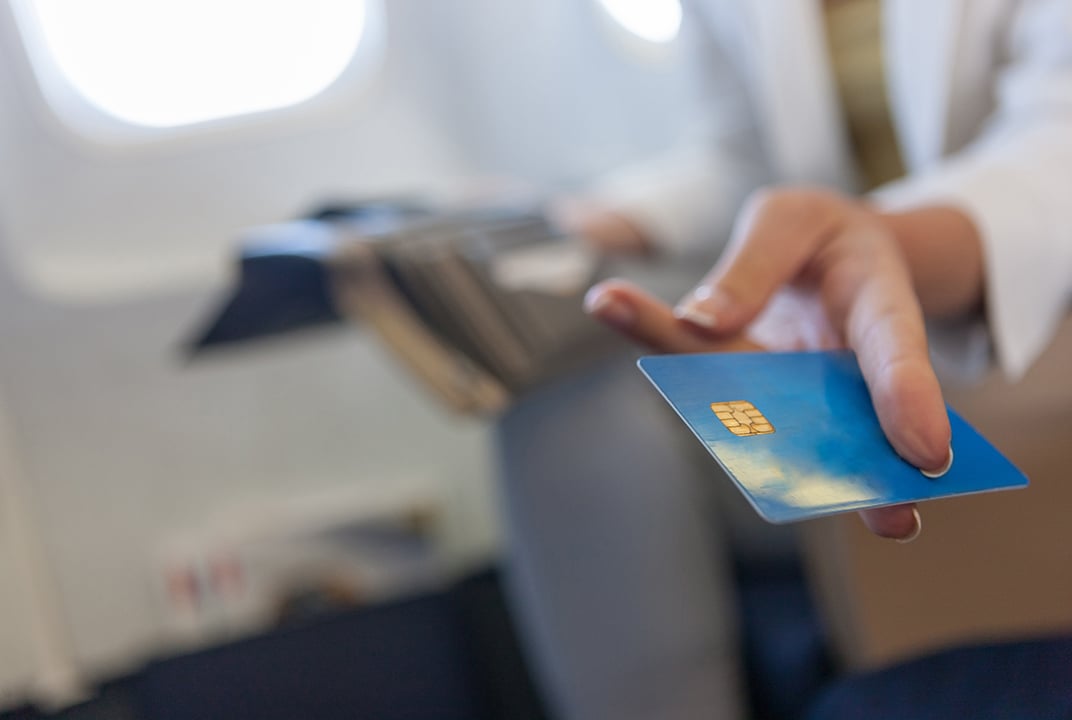Insight | The future of inflight retail
The future of inflight retail
As the last bastion of unconnected retail goes online, what changes will this bring?
Here’s a sobering statistic. Only one in ten passengers now makes an inflight duty free purchase. This equates to 10-12 sales on a short haul flight and 30-40 on a wide-body long haul. What’s more, this figure is falling slowly year-on-year – and the big three US carriers recently announced they would be pulling the plug on inflight duty free.
This, however, is in stark contrast to the total market. Duty free sales are booming.
A 2016 report by m1nd-set Generation suggested they would grow on average 6.8% per annum over the next decade, doubling by 2025, but airline sales are forecast to fall by -1.5% each year.
What’s the explanation for this? The answer is pretty simple. Those nice airports like Dubai and Singapore? The ones that look like upmarket shopping malls? They are upmarket shopping malls. Places like these are where flyers do 60% of their in-travel shopping.
"Nowadays inflight retail accounts for a mere 5% of travel spend."
Inflight shopping is seen as tired and dated. Passengers have become desensitised to the offer. According to Counter Intelligence Retail, the biggest category for inflight sales is female fragrances. The second biggest is alcohol. This hasn’t changed for decades.
Of course, there are good reasons that carriers struggle to compete with airports. Stock is bulky so ranges are very limited. The shopping experience is much diminished. Flyers can’t interrogate. To customers used to pointing, clicking and zooming in on items online, nothing looks quite as good in a printed catalogue. Meanwhile cabin attendants only moonlight as retail assistants. Sales are neither their focus nor their area of expertise.
If the range and the attraction are low, the overheads are high and the logistics complex. As well as the physically heavy stock, the carts are heavy too and even the catalogues add to the load. Anything that isn’t sold is dead weight. Inventory management is a challenge in the air, forecasting and restocking difficult. And of course, fraud is a persistent problem when credit cards can’t be authorised in real-time. Runway Girl Network estimates the cost to airlines runs to hundreds of millions of dollars every year. Ultimately, inflight retail just hasn’t been a priority for the industry, as the ancillary focus has moved to à la carte pricing for seat, baggage and boarding upgrades.
As we know, though, for many carriers’ inflight retail remains a valuable revenue stream. According to GuestLogix, for some this represents up to $200m a year. So how do airlines reinvent retail for the 2020s?
Connectivity – the game-changer
There are plenty of inflight retail innovations aimed at fighting back. Carriers such as British Airways and Swiss allow passengers to browse their catalogue before they fly, then collect in-air. Others take orders outbound, and deliver on the return. Some airlines now offer some form of home delivery. And many, like Lufthansa, have integrated their sales platforms into seatback entertainment systems. Korean Air, famously, has introduced physical SkyShops on its A380 fleet, foregoing 13 economy seats in the process. But even so, inflight retail underperforms.
Retail week calculated that the potential extra inflight spending was $2.47 Billion.
The internet has completely changed the way consumers shop on the ground and it has the potential to transform the way we shop in the air as well. Quite simply, 35,000 feet is one of the last bastions of unconnected retail. Over the next few years, though, it’s going to catch up very quickly, as broadband becomes ubiquitous. Retail Week recently calculated that the potential extra inflight spending based on terrestrial online shopping habits is as much as $2.47 billion. And connected retail represents a real opportunity to align passenger and carrier value.
More than just perfume: inflight connectivity will help airlines increase on board duty free sales by providing a simpler, faster, more secure and extensive shopping experience than was previously possible.
Connected commerce ushers in the switch from selling very limited ranges to selling anything – and in more sophisticated ways. Rather than encouraging impulse sales of generic products, airlines can provide online stores packed with everything from onwards travel tickets and destination activities to groceries to pick up on the way home.
Destination-specific content and commercial offerings could become a reality as airlines realise the retail potential of inflight Wi-Fi.
At a functional level, digital retail removes the challenge of carrying goods onboard, and managing tight stock forecasts, meaning airlines can vastly extend their inventory. It means offering more imaginative, higher value, lower volume items that drive overall margins and create the kind of retail headlines that draw shoppers in. And, of course, self-service shopping extends the retail window beyond the few minutes cabin staff can dedicate to it.
More convenience for passengers means better conversion to sale. Connectivity makes on-the-ground delivery much simpler, whether to a destination or home address. It also allows for more convenient closed-loop payment methods that don’t have to be a burden on cabin crew. Not just instant credit card authorisation, but mobile purchase or paying with loyalty points. And Wi-Fi will enable passengers to troubleshoot their own problems, satisfying the demand to have more control over their experience, like booking connecting flights in case of a delay.
Expanding retail options will require airlines to make strategic choices. While many will no doubt focus on an in-house offering, acting as gateway to a newly enhanced shopping opportunity makes new retail partnerships possible. Like Finnair’s Nordic Sky portal, carriers can strike innovative deals to turn their inflight catalogues into digital department stores, with branded concessions and revenues shared.
More personalisation, better experiences
Connectivity also means data, improving the relevance of the retail offering. Product differentiation is especially important as airlines seek to compete with more mature retail models applied at airports. Inflight e-commerce gives airlines greater flexibility to target offers, and messaging, to the cabin class, flight demographic or destination. Passengers already on their journey are primed for destination-related travel services creating the potential for carriers to be major retailers of last minute inventory, onwards travel and destination experiences. This sort of synergy explains Air Asia’s recent investment in travel site Touristy.
But the ultimate in retail relevance is personalisation. As the New York Times recently put it, “on an airplane you have a captive market, and with sophisticated technology you can sell to passengers in very personal ways”. Airlines already have access to a great deal of passenger data. This insight is enriched by online behaviour and purchase history. With it, airlines have the potential to learn from the e-commerce giants and predict and personalise recommendations and offers to step change conversion to sale – whether that’s a favourite clothing brand or a favourite inflight drink. And if integrated with an airline app to pre-advertise the offering, there’s the potential to bypass the airport’s grip on sales.
Personalised recommendations, powered by data, will help drive sales and customer loyalty
Big data, big challenges
Connected inflight retail is a huge opportunity for the industry – but also a great challenge. It implies a move from a model centred on seat sales and yield, to one that leverages the power of individual customer data across the entire journey. Airlines have access to big passenger data, but currently much of that data is unstructured and scattered across the organisation. Deep data, like frequent flyer profiles, is often unconnected to other sources. The potential for value creation is vast, but adoption of leading edge data warehousing and manipulation techniques has been slow across the industry. If airlines want to maximise the opportunity, there needs to be greater investment in data infrastructure, and the expertise needed to construct more personalised, customer-focused strategies.
Of course, there are some pioneers in this area – British Airways already uses a ‘Know Me’ feature to allow in-depth data analysis by customer in order to deliver personalised offers, while Alaskan Airlines claims its data collection strategy rivals that of political campaigns. United recently switched from a traditional ‘collect and analyse’ approach for upselling add-ons to a smart ‘collect, detect, act’ system, using artificial intelligence to analyse 150 variables in a customer profile in 200 milliseconds to determine a flyer’s likely preferences, and then tailor-make ancillary offers. The system has reportedly increased revenues by over 15% annually.
"British Airways already uses a ‘Know Me’ feature to allow in-depth analysis of data for each customer"
Ultimately, this isn’t just about changing the customer offer, it’s about changing behaviours. The greatest opportunity exists for those that shift their thinking and actions towards being in the travel category, not just the air transport business. If the goal is to drive ancillaries, the need is to focus on deeper passenger relationships rather than renting customers from online travel companies. The problem is that the online travel retailers intercept passenger queries in digital search and advertising long before they get anywhere near an airline. So the greatest challenge lies in changing travellers’ ingrained behaviour of going direct to the travel agent or aggregator, hotel or car hire company without even thinking of buying via an airline, before or during the flight.
The competition is fierce, and airlines are a long way behind. But if airlines can use data to provide a truly personalised experience, they have the potential to reinvent themselves from sellers of seats to digital travel retailers.


